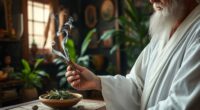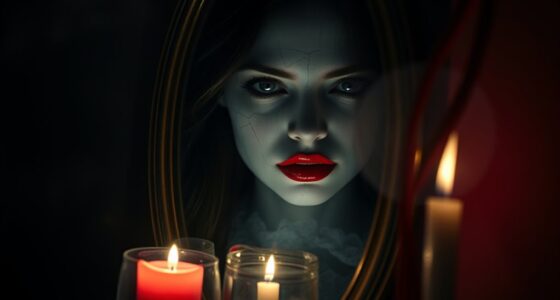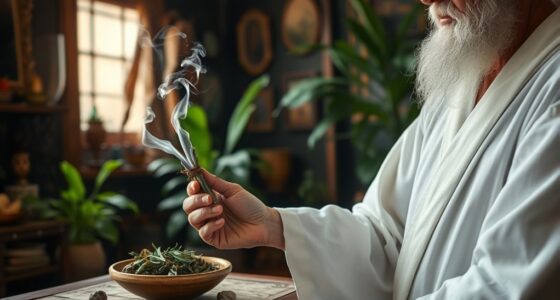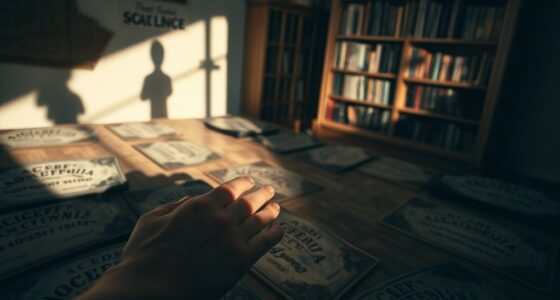Ghost hunting shows often blur fact and fiction by using tricks, effects, and staged scenes to create spooky moments. Producers rely on camera angles, lighting, and editing to hide crew and add illusions of paranormal activity. Many so-called evidence items are manipulated or fake, making it clear that entertainment is the main goal. If you keep exploring, you’ll uncover how these shows craft their mysteries and why skepticism is essential.
Key Takeaways
- Ghost hunting shows often use filming tricks and special effects to create the illusion of paranormal activity.
- Many claimed “evidence” is staged or manipulated using editing, camera angles, and environmental effects.
- TV shows tend to dramatize paranormal phenomena, which rarely reflect real-life experiences.
- Recognizing common filming techniques helps differentiate genuine events from staged illusions.
- Overall, ghost hunting TV programs prioritize entertainment over scientific accuracy, making their “truth” often a myth.
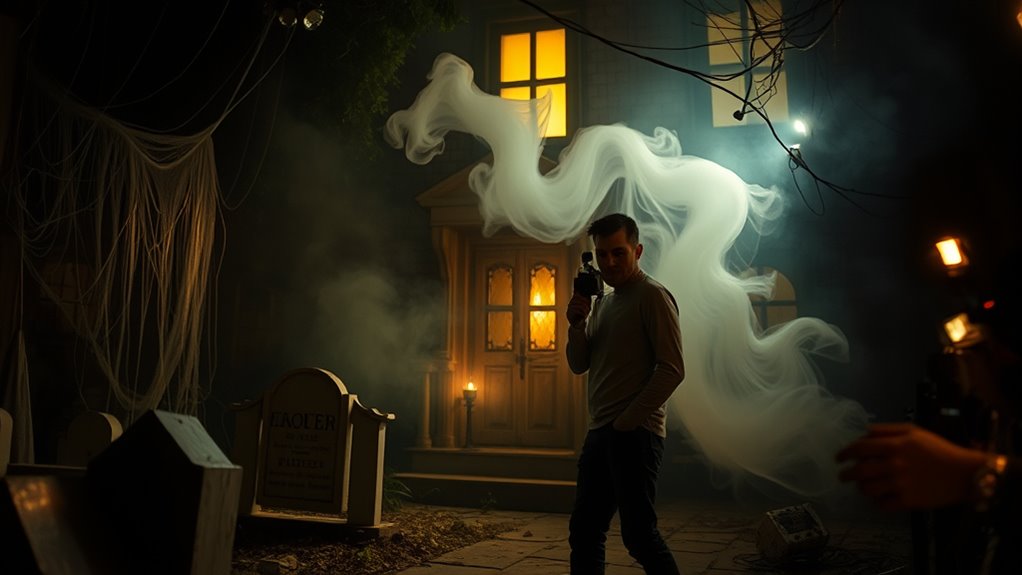
Television often portrays a glamorous, simplified version of real life, but the truth is that what you see on screen rarely reflects everyday experiences. When it comes to ghost hunting shows, many viewers assume that every eerie sound or shadow figure they see is genuine. However, these shows often rely on paranormal deception and filming illusions to create a more dramatic and engaging story. Producers know that viewers are captivated by suspense, so they use tricks to heighten the sense of mystery. For example, they might add atmospheric effects like fog or flickering lights, or employ editing techniques that make mundane objects appear ghostly. These tactics aren’t necessarily dishonest—they’re part of the entertainment value—but they do distort the reality of what’s actually happening.
In many cases, what you see on these shows isn’t a real paranormal encounter but a carefully crafted illusion. Filming illusions can involve camera angles that hide wires or hidden crew members, or they might use audio effects to make ordinary sounds seem paranormal. Sometimes, the crew intentionally manipulates the environment to spark unexplained phenomena, but it’s rarely spontaneous or supernatural. Instead, it’s a clever combination of special effects, camera tricks, and staged scenarios designed to keep viewers on the edge of their seats. Recognizing the filming techniques used can help viewers maintain a more skeptical perspective. Additionally, understanding the use of special effects can reveal how easily the supernatural can be simulated through technical means. Knowing about paranormal deception also emphasizes the importance of critical thinking when evaluating what’s presented. Furthermore, many of these shows employ staged scenarios that are carefully planned to maximize suspense and viewer engagement. Recognizing how much of what you see is constructed can change your perspective. Understand that many of the “evidence” presented on ghost hunting shows is often the result of filming illusions or deliberate deception. It’s easy to get swept up in the excitement, but maintaining a critical eye helps separate fact from fiction. Paranormal deception isn’t always malicious; sometimes it’s just part of the storytelling process to make the show more engaging. Still, it’s important to remember that these shows are designed to entertain, not to serve as scientific proof of ghostly activity. Additionally, the use of special effects and staged scenarios can sometimes be mistaken for genuine paranormal phenomena, which underscores the need for skepticism.
Frequently Asked Questions
How Do Ghost Hunting Shows Select Their Locations?
You might wonder how ghost hunting shows choose their locations. Typically, they focus on haunted sites with a reputation for paranormal activity, often based on local legends or reported experiences. Producers consider accessibility, safety, and the site’s history during location selection. They aim for spots that will engage viewers and create an eerie atmosphere, ensuring the haunted sites are intriguing enough to justify the investigation and heighten the show’s appeal.
Are the Supernatural Effects Real or Staged?
You might wonder if supernatural effects are real or staged. Often, ghost hunting shows use paranormal deception and reality fabrication to entertain viewers, making effects appear more convincing than they truly are. While some effects are genuinely supernatural, many are carefully crafted illusions or edited scenes. So, don’t take everything at face value—what you see on TV is often a mix of reality and theatricality.
What Equipment Is Genuinely Used in Ghost Investigations?
Think of ghost detection equipment as your toolkit for peering into shadows. In real investigations, you’ll find devices like EMF meters, thermal cameras, and digital voice recorders. These tools help detect subtle changes or unexplained phenomena, providing data for paranormal investigations. While some equipment is essential, remember that true ghost hunting relies on careful observation and critical thinking, not just gadgets. Stay curious, and use your equipment wisely.
How Much of the Show Is Scripted Versus Spontaneous?
You might wonder how much of the show is scripted versus spontaneous. Typically, ghost hunting shows blend scripted elements with spontaneity factors, but the spontaneity is often amplified for entertainment. While some moments are genuine, producers may plan key scenes or reactions to ensure entertainment value. So, your favorite ghost adventures involve a mix, but real spontaneous reactions can be limited by the show’s need for structure and pacing.
Do Ghost Hunting Shows Have Scientific Validation?
You might wonder if ghost hunting shows have scientific validation. In reality, paranormal research often lacks rigorous scientific skepticism, making many claims unverified. While some investigators use tools like EMF meters or infrared cameras, these aren’t always scientifically validated for detecting ghosts. As a viewer, you should remain critical, recognizing that most ghost hunting shows prioritize entertainment over scientific proof, so their claims often aren’t backed by solid evidence.
Conclusion
Remember, what you see on TV is often just the tip of the iceberg. Ghost hunting shows may dazzle with special effects and dramatic moments, but reality is much quieter and more cautious. Don’t forget the saying, “Don’t judge a book by its cover.” Just like a calm lake hides deep secrets beneath, real investigations require patience and skepticism. Keep your eyes open, and you’ll see the truth lurking beneath the surface, waiting to be uncovered.

